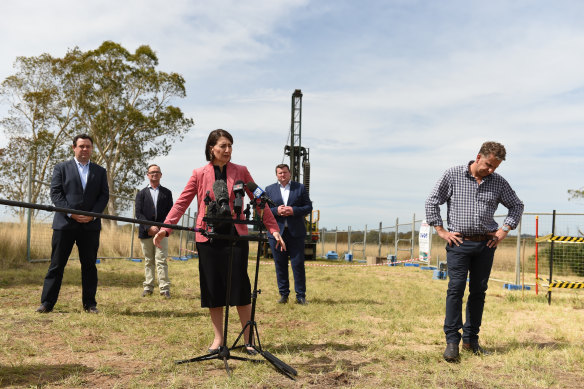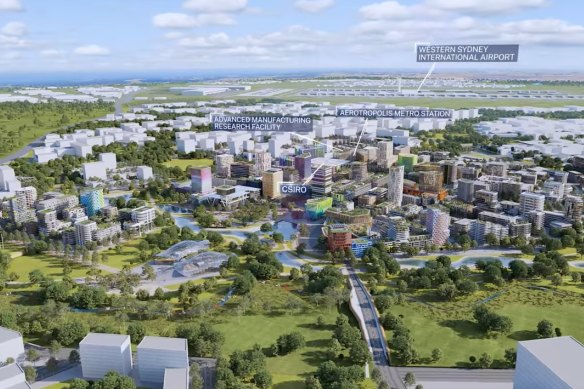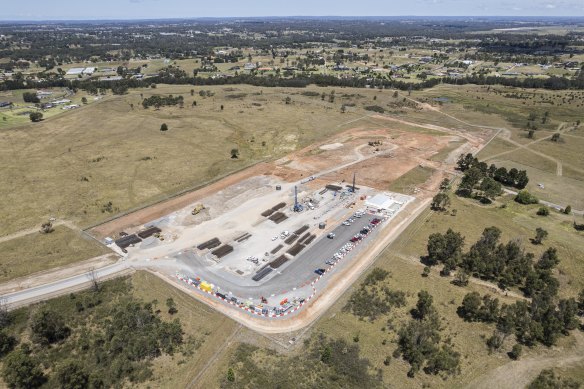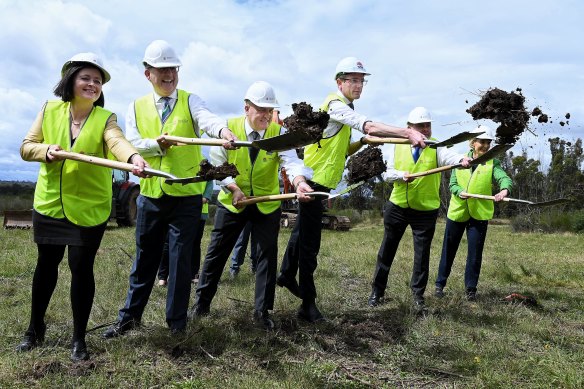Nearly two years ago, then-premier Gladys Berejiklian stood in a field in Sydney’s outer west and proclaimed the birth of a new “city” called Bradfield, an aerotropolis to accompany the looming Western Sydney Airport just nearby.
Long in the planning, it would be Sydney’s third city after the eastern CBD and Parramatta. But Bradfield would be a thoroughly 22nd-century place, Berejiklian said: “The city of the future.”
It is fast becoming reality. Within weeks, work will commence on Bradfield’s first building, to be home to a collaborative centre run by Japanese multinational Hitachi and the first stage of a new advanced manufacturing and research facility.
Shortly after, tunnelling will start for the metro line that will link the city centre to the airport terminal and St Marys. A master plan will be released next year, and city’s first doors are due to swing open alongside the airport in 2026.
The vision is grand, the rhetoric is lofty, the plans are ambitious. But there are also plenty who doubt that Bradfield can live up to the hype, and a slew of naysayers concerned the new city will inevitably suck the life out of nearby centres such as Liverpool, Penrith and Campbelltown.
“It’s going to be a black hole of government expenditure for at least a decade,” says Liverpool’s Liberal mayor Ned Mannoun. “City centres have amenity. Penrith and Liverpool have rivers. They already have people there. When you finish work in Bradfield, what are you going to be able to do?”
The government organisation charged with answering that question is the Western Parkland City Authority – specifically its chair, Jennifer Westacott, and chief executive Sarah Hill.
In a wide-ranging interview, they assure the Herald they are conscious of the dangers of building a brand-new city in what is currently 114 hectares of paddocks. They are especially keen to avoid the perception that Bradfield will be an industrial wasteland that shuts at 5pm.
“One of the things we have as a sort of check for ourselves is: let’s make sure we’re not creating a really big business park,” says Westacott, who is also the long-serving chief executive of the Business Council of Australia.
Cultural attractions, a “Central Park” and a swimming area are part of the brief. Hill is adamant Bradfield will have a nighttime economy too. “This will be a really high-quality destination for people in western Sydney to come to eat, to shop, to have culture,” she says.
The government is planning for people to live in Bradfield, too, although the initial numbers are modest: 3000 to 4000 residents in 1200 to 1500 homes over the next 10 years or so, scaling up to 8000 homes over time.
Geographically, Bradfield city centre is only a small part of the massive airport precinct that will materialise in coming decades. The aerotropolis – largely private land – is approximately 11,000 hectares. A lot of infill development is expected to take place to the north along the metro line.
“A lot of the housing will be picked up in places like St Marys because you are basically going to be sitting on the two big interchanges,” says Westacott.
City of the future
Bradfield city centre will be shaped using a “superblock” model popularised in Barcelona. In this approach to urban planning, traffic is mostly confined to a few major roads which form a grid of large blocks. Within those blocks are smaller, shared streets designed for people instead of cars. Vehicles can still use them, but at very slow speeds. For reference, think Spice Alley within the Central Park development in Chippendale.

Gladys Berejiklian, then premier, with ministers Stuart Ayres and Andrew Constance announcing the location of airport metro stations in 2020.Credit: Jacky Ghossein
The buildings will be different, too. Westacott and Hill say the old retail-centric approach to city formation – behemoth shopping malls or long high streets – is dead. It’s now all about mixed-use.
“If you go to the new cities in Japan, the new cities in Asia, they’ve got retail in the middle of apartment buildings, they’ve got innovation hubs mixed with retail mixed with a hotel mixed with accommodation,” says Westacott.
But Bradfield is unapologetically about jobs first. Westacott and Hill say they want to upend the traditional Sydney affliction where homes get built, infrastructure follows (if you’re lucky) and a spattering of jobs is eventually, maybe, dragged in later.
“We want to correct that by making this about industry and jobs and knowledge and innovation,” Westacott says.

An early conceptual drawing of what the Bradfield city centre could look like. From a video by the Western Parklands City Authority.Credit: NSW government
For Hill, who previously ran the Greater Sydney Commission (now Greater Cities Commission) for four years, it is about undoing “the great unfairness in terms of jobs” inflicted on western Sydney. Despite the population of the Western Parklands City being 60 per cent of the “Eastern Harbour City”, it only has about a quarter of the number of jobs.
Industry will be buttressed by a significant tertiary education presence, with several universities interested in having a presence in Bradfield. That includes, naturally, Western Sydney University, even if its Centre for Western Sydney shamed Berejiklian and the government for naming the city after 20th-century engineer John Bradfield instead of a woman or a First Nations person.
The city currently has about 27 “foundation partners”, Westacott says, including the first private sector tenant Hitachi, BAE Systems, space companies and General Electric. “We want them [GE] to set up in the aerotropolis and make western Sydney their centre for the Asia Pacific region to do their 3D printing.”

Bradfield, slated to become Sydney’s third city, will soon take shape.Credit: Brook Mitchell
The level of Japanese interest is notable. In November, the Herald attended a market-sounding event held at the Twin Creeks Golf and Country Club for firms that believe they can contribute to the city’s energy, digital and circular economy needs. The room was dominated by Japanese delegations.
“They’re dealing with zero population growth, they’re dealing with pretty mature assets,” Westacott says. “They look around the world and say: where’s the market that allows us to grow and expand?”
Late in 2022 the government started seeking expressions of interest from business incubators, accelerators and co-working spaces to co-locate with Hitachi in building one, as well as education and research institutions for buildings four and five.
Westacott says the challenge now is to attract more of the big Indian tech companies. “They’re just so advanced on the technology front. And the thing the Indians are incredible at is cost reduction. They can send a satellite into space for $US300 million. It costs NASA a couple of billion.”
What about us?
One compelling reason for companies local and global to consider Bradfield instead of somewhere else is that the scheme is effectively secured by taxpayers. The government is the planner and the developer, and has already committed at least $1.15 billion to kickstart works.
“We’re de-risking very much,” says Hill. “Us going in really catalysing the change from inside out means we can focus on putting the building blocks in place – the roads, the infrastructure – which really unlocks other sites around that.”
Announcing the Bradfield name in that paddock two years ago, Berejiklian remarked that people in Parramatta “won’t be looking east for the best jobs of the future, they’ll be looking here”.
So, the government has picked Bradfield as a winner. But that leaves places like Liverpool, Penrith, Campbelltown and Parramatta wondering: where do we stand?
“The government would have been better off working on those city centres and putting more money into them,” says Ned Mannoun, the Liberal mayor of Liverpool. He wonders whether the thing will work at all. “If I’m an employer, why am I going to be in an area that has more cows than people?”
Adam Leto, chief executive of the Western Sydney Leadership Dialogue think tank, says Bradfield is conceptually sound: there ought to be a city around the new airport, and it’s right to be designed around industry and jobs. But “you need to do so without sucking the life out of the other centres”.
Leto says expectations need to be tempered and priorities reset. “The focus from government has been mainly on how to grow that precinct, which is fair,” he says. “But they need to do that while also not overlooking the need to continue to support the growth of other areas.”
There is a concern among some western Sydney leaders and advocates that just as Parramatta was coming into its own as a second CBD – assisted by the relocation of truckloads of government jobs – along comes Bradfield.
“We sent a clear signal to the market that this [Parramatta] is a place to invest,” says Leto, while places like Liverpool, Campbelltown and Penrith “are still looking toward government to provide that kind of support”.
National significance
Businessman and western Sydney champion Tony Shepherd says it’s wrong to see the arrival of Bradfield as a threat to surrounding centres – it’s not a zero-sum game or a competition. “It’s a lot closer to Liverpool than Mascot or the Sydney CBD,” he says. “I don’t see it as winners and losers. I think everybody benefits.”
Shepherd, who chairs the government’s Modern Manufacturing Taskforce, is adamant Bradfield will play a nationally significant role in reorienting Australia’s ability to make things that are relevant in the 21st and indeed 22nd centuries.
“We just can’t go on having 4 per cent of our manufacturing done locally,” Shepherd says. “With the supply chain issues we’ve got at the moment, we just can’t keep going like that. It’s too risky.”
The taskforce’s report earlier this year, Time for Action, notes NSW manufacturing has gradually lost its share of the “Industry Gross Value Added” national total to Queensland and Western Australia, though this trend has stabilised.
“NSW remains the largest manufacturing state in Australia based on IVA, but only sits just above Victoria,” the report says.

Minister for Western Sydney David Elliott and Premier Dominic Perrottet during the turning the sod ceremony at Bradfield in September.Credit: Kate Geraghty
The report only mentions Bradfield fleetingly, but it does identify several advanced manufacturing and technology hubs around the world which could act as inspirations for the future city – including Israel, the UK city of Sheffield, Canada’s Ontario and the German region of Bavaria.
“Although Bavaria is home to global players like Adidas, Allianz, BMW and Siemens, the backbone of its economy is a population of medium-sized enterprises, many of whom are acknowledged as global market leaders,” the report says.
Shepherd believes the government’s grand ambitions are achievable. “We’re not talking about [another] Macquarie Park here. We’re talking about a science and technology hub in which the government is investing significantly. It is not an unproven approach,” he says.
“We’re talking about an area which will have 3 million people by 2030. This is [geographically] bigger than Adelaide, bigger than Perth, two-thirds of the size of Brisbane: a massive area, massive population. They’re all good, hardworking people and they want jobs for themselves and their kids.”
The Morning Edition newsletter is our guide to the day’s most important and interesting stories, analysis and insights. Sign up here.